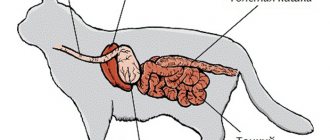Cause of the disease
Our pets, like people, are susceptible to a variety of ailments.
Do dogs suffer from tick-borne encephalitis and borreliosis? Not everyone has heard of the latest misfortune. But the danger, meanwhile, should not be underestimated. Unfortunately, the answer to the question of whether dogs suffer from encephalitis and borreliosis is affirmative. Tick-borne borreliosis, otherwise known as Lyme disease, is one of the widespread diseases found among dogs. It is transmitted by ixodid ticks. The causative agent of the disease is the bacterium Borrelia burgdorferi, which belongs to the group of spirochetoses.
The pathogen enters the animal's body through a tick bite. Humans are susceptible to a similar route of infection. Signs of borreliosis in dogs are nonspecific.
An animal can only get sick with it during the warm season, but due to the long incubation period (several months), the clinical picture can only be detected in winter.
The causative agent of the infectious disease borreliosis (Lyme disease) is a spirochete (genus Borrelia). Ticks contain them in the salivary glands and are injected into the wound during a bite along with saliva. Insects pass the infection on to their generations.
Ticks are especially active from May to August, but they can infect through a bite in other months of the warm season. In different regions of the country, tick infestation ranges from 10 to 50%.
The spirochete from the wound at the site of the tick bite penetrates the circulatory and lymphatic systems and spreads throughout the body, reaching almost all organs. The disease is not transmitted from person to person.
The latent period (from infection to the manifestation of the disease) can be 2-30 days, on average it lasts 7-10 days. In the clinic, the disease is divided into 3 stages.
- Stage 1 of the disease has an acute onset: headache, general weakness, muscle pain, nausea, possibly vomiting, joint pain. Some children may experience a runny nose, conjunctivitis, a fever of up to 38°C, and an enlarged spleen and liver. The lymph nodes closest to the site of tick penetration enlarge.
The most characteristic symptom of Lyme disease is the appearance of a red spot (up to 1 cm in diameter) at the site of the bite with mild itching and pain. The size of the spot quickly increases (sometimes up to 20 cm), takes on an oval or round shape. The center of the spot turns pale, and the bright pink edges slightly rise above the surface of the skin - a ring-shaped rash forms.
Gradually, such spots (somewhat lighter and without a clear boundary) appear on other parts of the body. Such rashes are called erythema migrans. They can merge with each other. Elements of the rash persist from several days to several weeks. After the rash disappears, pigmentation remains.
- Stage 2 develops in the absence of treatment 2-3 weeks after the onset of the disease. It is characterized by damage to various organs. The most pronounced manifestations are from the nervous, cardiovascular systems, and joints.
Frequent manifestations are neuritis of the cranial nerves (oculomotor, facial, auditory), serous meningitis or meningoencephalitis with paresis and paralysis of the limbs. With inflammation of the meninges (meningitis), the child experiences a sharp headache with nausea and vomiting, dizziness, and photophobia.
Numbness in the limbs and a crawling sensation may appear. Sleep is disturbed, the child is restless. Sudden disturbances of consciousness and convulsive attacks may occur. At this stage, neurological manifestations are reversible and disappear with treatment after 1-2 months.
At 2-3 months of the disease, the heart is affected: heart pain, shortness of breath, and palpitations appear. These symptoms are reversible.
Other organs may be affected: the liver (increases in size, yellowness and dark color of urine appear), the organ of vision (inflammation of one of the membranes of the eye or all of them), joints (knee, elbow, shoulder, small joints of the feet and hands).
Not every sick child will necessarily have all the symptoms of damage to different systems, so diagnosis is difficult in some cases.
- Stage 3 of borreliosis is characterized by the transition of the disease to a chronic form. Changes in organs and systems are permanent and irreversible. Treatment usually brings only minor improvement.
PATHOGENESIS OF BORRELIOSIS IN ANIMALS AND HUMANS
Unlike Leptospira, Borrelia do not survive in a free environment. They are host-associated and transferred between vertebrate reservoir hosts and blood-sucking arthropods. The main vectors of Borrelia burgdorferi sensu lato are various species of ixodid ticks. Y. ricinus and Y. persulcatus are the main vectors in Europe and Asia and China, respectively. In the United States, black-legged ticks Y. scapularis (Northeast, Midwest, Southeast), Y. pacificus (West) are the main vectors. These small ixodid ticks (less than 3 mm) most often feed on more than one host during their life cycle.
Y. scapularis is a three-host tick with a two-year life cycle. The infected nymph overwinters and in the spring transmits the infection to the reservoir host, which returns the infection by feeding the larvae. Larvae and nymphs feed initially on rodents and small mammals (northern Y. scapularis) and reptiles (southern Y. scapularis), while adult ticks feed on deer and other large mammals. People and pets are usually infected by nymphs or adult ticks. Because reptiles are poor reserve hosts, infection rates in southern Y. scapularis are much lower than in northern ones. Moreover, since southern ticks do not feed on mammals, the presence of Borrelia infection is relatively lower in southern regions. Other ticks and insect vectors can harbor Borrelia. But they are not the main source of infection and an important vector. Direct transfer of spirochetes is not possible, since it is transovarial transfer in ticks. Dog urine is also not a suitable source of spread. In a natural infection model, control dogs kept with infected dogs for a year did not show an increase in antibodies and microorganisms were not isolated from the urine of infected dogs. These studies also do not document any incidence of intrauterine transmission. However, Borrelia can survive freezing and storage, making artificial insemination a potential source of contamination. Blood transfusion is another potential source of infection.
Natural transmission of spirochetes takes 48 hours from tick attachment, during which the m/o multiply and pass through the intestinal epithelium into the hemolymph, colonize the salivary glands and infect the host with tick saliva. Once in the body, spirochetes usually cause persistent infection. Obvious experimental suggestions exist that m/o Borrelia is a strictly extracellular parasite and, in an unclear way, can escape immune elimination. M/s can reside and germinate for a long period (possibly throughout the life of most animals) in the intercellular spaces, in the skin at the site of a tick bite. Most infected animals never show clinical signs. In dogs that do not show clinical signs, Borrelia probably persists but does not affect the connective tissue and therefore does not cause clinical signs, but may cause persistent antibodies. In very few animals, Borrelia multiply and migrate from the skin of the bite site through the connective tissue, including joints, starting with those closest to the bite site. Clinical manifestations of the disease in these dogs lead to an inflammatory response in the owner to their presence and migration. Despite treatment, spirochetes may persist for several months or years in the skin, connective tissues, joints, and nervous system and can be detected by PCR, or sometimes by blood, CSF, or urine culture.
It is not yet known why a particular animal or person begins to show clinical signs. The pathogenesis depends on the Borrelia species and B. burgdorferi sensu stricto appears to be more pathogenic in dogs than the species found mostly in Europe. It is estimated that 5-10% of dogs with antibodies in endemic areas in the United States show clinical signs of disease within 2 to 5 months after infection, with a much smaller percentage in endemic areas in Northern Europe. Experimental studies have shown that the number of infected ticks that feed is limited. The age and immune status of the animal is also important, and treatment with high doses of corticosteroids during infection increases the likelihood of clinical signs. The development of immune complications, such as arthritis, is probably associated with host immunodeficiency. People with a certain major histocompatibility complex haplotype are prone to more severe manifestations of the disease.
What kind of disease is this?
This name - borreliosis - is adopted in domestic practice by the name of the bacterium that causes it. The American variant is Lyme disease (this is the name of the city where the pathogen was first discovered).
Wherever ixodid ticks live, infection with this disease is possible. The causative agents of infection are already contained in the bodies of tick larvae. Not every insect is a carrier of the disease, but the risk of getting it is greater where there is a high level of coverage of this infection.
The disease can be “caught” in urban conditions, but the “wild” (i.e. natural) environment creates much more preconditions for infection.
From 5 to 10% of the entire dog population is able to resist the dangerous bacterium. The risk of infection is less the sooner the tick is removed from the animal. In addition, urgent intervention has a positive effect on the manifestation of symptoms of the disease.
The severity of the clinical picture is directly related to the concentration of the pathogen entering the blood. If you manage to remove an adult tick from the bitten area within 24 hours, you can prevent the transmission and development of infection.
To carry out treatment, you must consult a doctor.
Veterinarians often use Tetracycline to treat feline borreliosis.
During the recovery process it is necessary to use:
- microelement complex hemovit-plus;
- vitamin and mineral supplement "Gamma", SA-37.
As a rule, cats respond fairly quickly to therapeutic measures. The condition of the joints and limbs improves noticeably, however, in most animals the characteristic symptoms of the disease remain. Sometimes, despite antibiotic therapy, the cat's condition remains unchanged and the infection persists.
The use of metabolic stimulants is also indicated. Catozal is considered one of the most effective drugs.
If you do not start professional veterinary treatment using medications or if it is carried out incorrectly, the disease becomes chronic. As the situation worsens, the gait changes, the lymph nodes swell, and the hind limbs stop bending. In this case, the disease becomes practically invincible and can lead to either disability or death.
How is this pathology diagnosed? Exclusively in a good veterinary clinic. Several serological reactions and collection of all data on the time preceding infection will be required. This is necessary to completely exclude the possibility of other diseases and prescribe truly effective therapy.
TREATMENT OF BORRELIOSIS IN ANIMALS
Because of the difficulty found in making an accurate diagnosis, antibiotics are often used empirically as a trial of therapy. There are many reports of successful recovery after a course of antimicrobial therapy in dogs with “diagnosed” Lyme arthritis. However, clinical improvements following any therapeutic intervention must be considered with caution because acute claudication and joint dysfunction are intermittent and often resolve within days to weeks regardless of antibiotics. Doxycycline is the drug of choice for tick-borne borelliosis, but it itself has a chondroprotective effect in non-infectious arthritis in dogs and thus leads to improvement in arthritis not associated with Lyme disease.
Antibiotics most effective for treating borreliosis
- these are tetracyclines, ampicillin or amoxicillin, intravenous cephalosporins of the 3rd generation and erythromycin and its derivatives. Doxycycline (given 10 mg/kg orally twice daily for 30 days) is the first choice because it is a fat-soluble tetracycline of relatively low cost. Other medications are usually reserved for persistent or chronic infections. Improvements often occur 24-48 hours after initiation of antimicrobial therapy. Significant success is achieved when used in the initial stage of a clinical disease. Research suggests that m/o is difficult to eliminate from animals with proven infection and that relapses occur despite the apparent adequacy of treatment. Most often, the treatment period is set at 30 days. However, based on scientific research, the purity of the body after 30 days of treatment is in question. Relapse may occur and PCR may become positive even after the end of antimicrobial therapy. Also, inflammatory changes that occur in various tissues, such as joints, can become persistent.
Tick-borne borreliosis in dogs: symptoms
Find the nearest pet store on the map
We invite you to familiarize yourself with: AVZ "UROLEX" urological drops for cats and dogs, 20 ml.
One of the varieties of ticks that can parasitize animals is the ixodid tick. It is this kind of tick that bites a cat that can become a source of infection for a dangerous disease.
Ixodid tick bites most often occur in spring and autumn. During these periods, ticks are most active, as they strive to continue their genus as soon as possible.
There is no doubt that a cat walking freely on the street or garden can easily be bitten by an ixodid tick. What about domestic felines who never leave their apartment?
Unfortunately, in the summer they are also susceptible to tick bites. Sometimes the owners themselves bring ticks from the street on their clothes.
Externally, the ixodid tick resembles a small spider. It has an oval body 3-4 mm long. After attaching to the skin of an animal, the parasite increases significantly in size: up to one and a half centimeters. After the tick has sucked blood, it spontaneously falls off the cat's skin.
Ticks are dark brown or black in color until saturated; The body of a tick that has drunk blood has a red or gray tint.
A cat that has just returned from a walk must be carefully examined. The tick does not attach itself immediately and may remain in the animal’s fur for some time.
At this time, it poses a danger not only to your pet, but also to you and your children. The reason for this is that the ixodid tick can also attach itself to humans. The danger of a tick bite for a person is infection with a deadly disease - tick-borne encephalitis.
Most often, ticks attach to animals:
- In the withers area;
- On the stomach;
- In the groin;
- In the armpits;
- Behind the ears.
A faithful assistant in protection against external parasites for many breeders and cat owners is the drug BlochNet max - anti-tick drops for cats. This product is intended for the prevention of tick bites and is recommended for use by veterinarians.
After applying BlochNet max to the withers, the drug protects the cat from ticks for four weeks.
- The effect is achieved within 24 hours after application;
- BlochNet max is safe. The drug is a low-toxic compound and does not cause allergies;
- Drops on the withers are the most convenient form of the drug for treating a cat against ticks;
- First opening control. The bottle of the drug has a tamper evident lid. This ensures safety and guarantees the purchase of the original drug.
- Carefully inspect your cat's skin and fur before applying the drops. A tick can get on your pet even before treatment;
- For constant reliable protection, BlochNet max drops are applied to the animal once every 23-25 days;
- Drops are applied to dry, intact skin of the animal in places inaccessible for licking. If applied to the fur, the protective effect of the drug may be absent or significantly reduced;
- To fully protect your pet, at least 48 hours must pass after treatment. After this time, the ticks will not bother the cat;
- There is no need to wash or bathe the animal for two days before and after applying the drug;
- If the cat's weight is borderline, treat the pet with a drug for a larger weight.
Dosage of the drug BlochNet max for cats
| Body mass | Drug dose |
| Up to 5 kg | 0.5 ml (15 drops) |
| More than 5 kg | 1 ml |
BlochNet spray is used for additional treatment of cats, for example, before going outdoors. To protect the animal from ticks, the drug must be sprayed on the cat’s paws and stomach 2 hours before visiting places where ticks may be located.
BlochNet spray is also effective for treating a cat’s bedding against external parasites, since ticks and fleas can often be found there. We'll tell you how to remove a tick from a cat below.
If you try to remove a tick from a cat’s skin without additional equipment, it can penetrate even deeper into the skin, the head of the tick will remain in your pet’s body, which will cause inflammation.
Many breeders and cat owners treat their pet for ticks with BlochNet max drops.
To remove a tick from a cat, apply one drop of the drug to the parasite and its attachment site. Wait 20 minutes. If the parasite does not fall off on its own during this time, carefully remove it from the skin using tweezers. Wrap the removed tick in a napkin and burn it.
There is an opinion that ixodid tick bites are harmless to cats. This is wrong. After a tick bite, a domestic cat can become infected with hemobartonellosis, borreliosis, theileriosis and other infectious and parasitic diseases.
Dangerous diseases carried by ixodid ticks:
- Hemobartonellosis is also known as feline infectious anemia. The causative agent of this disease is a special type of microorganism, Bartonella, which enters the cat’s body after a tick bite. Microorganisms affect red blood cells (erythrocytes) and hematopoietic organs (liver, spleen). The disease often occurs in a latent, asymptomatic form.
- Borreliosis (Lyme disease) is an infectious disease caused by bacteria from the genus Borrelia. These bacteria multiply in the blood of an animal infected through a tick bite. The waste products of the borreliosis pathogen cause a severe allergic reaction and pain in the muscles, joints, heart, and sometimes damage to the kidneys and brain is observed.
- Theileriosis in cats is caused by single-celled parasites. The source of the disease is sick animals, the carrier is the ixodid tick. Cats are difficult to tolerate this disease. The causative agent of theileriosis lives in the blood, liver cells, lungs, spleen, and lymph nodes. The disease is difficult to treat.
- Babesiosis in cats is rare in Russia. Babesia are intracellular parasites. They penetrate blood cells and cause their destruction. The disease progresses quickly, and the pet’s death can occur within two days after the first signs of the disease appear.
In any case, after removing the parasite from the animal’s skin, monitor your pet’s well-being for two to three weeks.
Symptoms that may occur after a tick bite in a cat:
- Lack of appetite;
- Lethargy and apathy;
- Pale mucous membranes of the eyes and mouth.
- Fever;
- Heavy breathing, shortness of breath.
Any change in the cat's behavior and well-being should alert you. If you notice at least one of the signs listed above, hurry up and contact your veterinarian with your pet. He will prescribe treatment for your cat that will help prevent the effects of the tick bite.
Advanced scientific developments and the production base of NVP Astrapharm guarantee pet owners high effectiveness of drugs and a confident solution to problems related to the health and maintenance of their pets.
We suggest you read: How to choose a cage for a hamster - online pet store Pets in the City
The video has been deleted.
| Video (click to play). |
We are proud that our drugs compete with foreign analogues and are highly valued by domestic experts. The preparations produced by our company have been awarded the gold “Quality Mark of the 21st Century”, confirming the product’s compliance with established requirements and guaranteeing its high quality to consumers.
Sources
- Ramzia, Timergaleevna Mannapova Honey, medicinal plants and kumiss / Ramzia Timergaleevna Mannapova, Zaria Zalilova und Renata Mannapova. - M.: Palmarium Academic Publishing, 2013. - 196 p.
- Khodusov, Alexander Porcine hematopinosis / Alexander Khodusov. - M.: LAP Lambert Academic Publishing, 2014. - 100 p.
- Meyer, Denny Veterinary Laboratory Medicine. Interpretation and diagnosis / Denny Meyer, John Harvey. - M.: Sofion, 2020. - 478 p.
Hello! My name is Valeriya. I have been working as a veterinarian for 5 years. I consider myself an excellent specialist and share my knowledge in the field of cat treatment with site visitors. The materials were collected and processed for ease of reading and obtaining all the necessary information in a form understandable to the average person. Before use, mandatory consultation with professionals is required.
A characteristic common feature of the symptoms is their nonspecificity. This means that in each individual case, different animals may show completely different signs of the disease. This is due to the general systemic nature of borreliosis in dogs, that is, the ability to affect many organs and systems at once. In addition, specific pathogens prefer certain tissues of the body.
In this regard, diagnosing the disease can become quite a difficult task - there may not be clear clinical signs.
1. The first of them begins at the moment of the bite and lasts from 20 to 30 days (in some cases - up to six months). At this time, the pathogen goes through a stage of active development in the skin tissues of the animal, but its spread beyond the boundaries of the lesion has not yet occurred. As a rule, there are no specific symptoms at this time.
2. The second stage is called clinical. Its onset is observed when the process of active migration of bacteria into the circulatory system of the animal develops, due to which they spread throughout the body.
Symptoms during this period depend on which system the pathological process is localized in.
CLINICAL SIGNS OF BORRELIOSIS IN DOGS
In all experimental infections of dogs, the strain Borrelia burgdorferi sensu stricto
Therefore, the clinical condition caused by this microorganism is relatively well described. In experimentally infected dogs, clinical disease begins within 2-5 months. after a tick bite. Clinical signs include fever, lack of appetite, lethargy, lymphadenopathy, and occasional lameness due to polyarthritis. Arthritis begins first in the joint closest to the site of the tick bite. This is observed because pro-inflammatory cytokines are released and interleukin-8 (it-8) plays an important role in the pathogenesis of acute arthritis. Despite the passing (transit) nature of arthritis, pathological changes in the joints progress; Chronic non-erosive arthritis is the primary condition after prolonged infection and this may persist despite antimicrobial therapy.
Clinical signs that develop from natural infections or infections caused by other Borrelia species are less well defined. Glomerulomhritis and protein-losing glomerulopathies progressing to renal impairment have been described in naturally infected dogs. Acute progressive renal failure associated with azotemia, uremia, protenuria, peripheral edema and body cavity effusion was described in 49 dogs with positive endemic Borrelia antibody tests.
Labradors and golden retrievers are most commonly affected. In Europe, glomerulonephritis is often found in Bury Mountain dogs with high titers of antibodies to Borrelia. Borrelia is likely, but not yet proven, to cause rapid progression of glomerular disease. Dermatological lesions due to expanding erythema around the site of the tick bite have not been well documented. Small reddish lesions, not as dramatic as the erythema migrans seen in humans, may be present but disappear within the first week. However, m\o can be released from the surface of the skin for a long period. Neurological manifestations caused by meningitis or encephalitis have not been well documented in other experimental or natural infections of dogs. In addition to arthritic syndromes, cardiac arrhythmias and myocarditis have been noted, similar to reports in humans.
There are no specific hematological or biochemical changes associated with Lyme disease. Unlike leptospirosis, leukocytosis is not observed, possibly due to the fact that Borrelia rarely spread hematogenously, but more often through connective tissue. Dogs with side effects may have proteinuria due to glomerulonephritis, sometimes secondary azotemia, hematuria, pyuria, cylindruria; analysis of synovial fluid shows a typical purulent polyarthritis with a leukocyte level from 2 to 100 thousand per microliter.
If the musculoskeletal system is affected
A common sign of borreliosis in dogs is joint damage. This pathological process occurs in the majority of sick individuals (about 80%). Signs of a pathological condition can be recognized by pain and swelling in the joints (or one of them), alternating lameness on different paws, occurring in periods of three to four days. Sometimes these attacks can be interspersed with “healthy” intervals of several weeks.
The dog loses its appetite, gets tired quickly, does not want to move and is depressed. All this often coincides with the beginning of the next exacerbation of lameness.
These symptoms may occur separately or in combination. They can most often be observed 1-6 months after the tick bite. Diagnosis due to this can sometimes be very difficult.
Symptoms: how does the disease manifest itself?
The incubation period ranges from 3 days to 1 month. Tick-borne borreliosis in cats develops slowly and has 3 stages, shown in the table:
| Degree | Time after bite | Symptoms |
| Acute | 1-3 weeks | Redness at the site of the bite |
| Appearance of a pink circle with a red center | ||
| Decreased appetite or refusal to eat | ||
| Unnatural sleepiness | ||
| Subacute | 2-5 months | Appearance of lameness |
| Joint pain and inflammation | ||
| Swelling of paws | ||
| Forced body position due to tetanic contraction of the flexor muscles | ||
| Aggression, behavior change | ||
| Heart rhythm disturbance | ||
| Temperature increase | ||
| Seizures and loss of consciousness | ||
| Vomit | ||
| Chronic | Over 6 months | Kidney failure and urinary dysfunction |
| Presence of protein and blood in urine | ||
| Deep, rapid breathing through an open mouth | ||
| Exhaustion | ||
| Difficulty swallowing | ||
| Impaired coordination of movements | ||
| Inappropriate behavior | ||
| Arthritis - progressive or recurrent |
If the cardiovascular system is damaged
When Borrelia attacks the heart muscle, symptoms associated with rapid breathing and heart palpitations may be observed. Since in general the animal body is usually quite resistant to the pathogen, the symptoms of borreliosis in dogs that are classified as cardiac may go unnoticed.
The infection will “lurk” in the body for a long time until it causes a more significant complication - inflammation of the heart muscle. Depending on how severe the pathological process is, you can observe arrhythmia, pulmonary edema, cyanosis of the mucous membranes, as well as other symptoms of heart failure in the animal.
PUBLIC HEALTH IN LYME DISEASE
It is not clear that domestic dogs and cats infected with tick-borne borelliosis pose a direct risk to humans, excluding the introduction of unfed ticks into the house. Ticks do not survive in the house for a long time, and if the tick is engorged, it will not transfer to another host without molting. However, a partially fed tick may feed again and thus carry a risk of infection since it requires a short period of attachment. Direct horizontal transmission from dogs and cats to humans is not possible. It is believed that urine from an infected dog can be a source of infection for humans. Borrelia, however, is rapidly destroyed in urine, and there is no definitive evidence that human infections have occurred after contact with infected dogs. Additionally, recent studies in the Netherlands found no positive correlation between the presence of antibodies in hunters compared to their dogs. Although Lyme disease is classified as a zoonosis, dogs, cats and humans are incidental hosts for the wild cycle that exists in nature. Lyme borreliosis in humans
usually associated with external activity that increases the likelihood of tick exposure.
^Top
Neuroborreliosis: when the nervous system is affected
Due to the disease, at a certain stage, a sharp deterioration in the general condition of the animal is possible. The dog’s appetite disappears, and spontaneous development of complete or partial paralysis of the limbs is possible, with the hind legs most often affected. This condition can last quite a long time, and its symptoms may completely disappear.
If the nerve centers of the spinal cord or brain are severely damaged, disturbances in the motor activity of the animal’s body may be irreversible. This manifests itself as permanent paresis, paralysis or dysfunction of internal organs. The dog is subjected to severe suffering and often dies.
If your kidneys are damaged
Disturbances in the functions of urination and urination caused by borreliosis in dogs manifest themselves in the form of frequent urination in small portions, accompanied by pain and traces of blood in the urine. Without treatment of this important organ, glomerulonephritis may occur with subsequent development of renal failure.
Symptoms in this case are reduced to diarrhea and vomiting, a sharp decrease (up to complete absence) of appetite, weight loss, thirst and increased urination. You can also often observe the development of subcutaneous edema in the abdominal cavity and on the surface of the thighs on the inside.
We emphasize once again that this disease is characterized by different symptoms in each individual case. Thoroughbred animals are much more likely to suffer from nervous system disorders and joint problems. Outbred dogs are more susceptible to kidney disease. In addition, any of the above complexes may be present either by itself or together with others.
How to make a diagnosis?
Due to the wide range of signs and possible symptoms, making a diagnosis, as already mentioned, is quite difficult. After all, such manifestations can occur in many extraneous cases. Perhaps the main sign indicating the likelihood of borreliosis is intermittent claudication, which the owner of the animal cannot help but pay attention to.
The veterinarian will have to carefully study all the signs, not forgetting at the same time about the possibility of simultaneous infection of the animal with a number of other diseases that can also be transmitted through a tick bite.
Diagnosis of the disease
When diagnosing borreliosis, detection of erythema migrans is complicated by the presence of hair. The main diagnostic method for the disease in cats and animal species is laboratory diagnosis.
Also carried out:
- PCR;
- microscopy methods;
- indirect immunofluorescence.
The diagnosis of borreliosis is made by a veterinarian if there are several indicators:
- Clinical signs;
- positive serological reaction;
- presence of a tick bite or information about contact with them;
- exclusion of other diseases.
Important. Cats suffer from borreliosis less often than dogs. The latter have a higher susceptibility to these mites.
What awaits a sick dog at the clinic?
1. To assess the function of the kidneys, pancreas and liver, a biochemical and complete blood test is performed. It is imperative to determine your blood sugar level.
2. Parallel diseases can be identified by microscopic analysis of a blood smear.
3. To exclude the possibility of infection with intestinal parasites, feces are examined.
4. The blood is examined for the level of water-salt metabolism in order to exclude the possibility of dehydration with electrolyte imbalance.
5. Urinary tract infection is detected using urine tests, including determination of protein in it.
6. You may have to resort to a thyroid test to determine hormone levels.
7. Heart problems, indicated by an abnormal rhythm of its work, are diagnosed during an ECG.
We suggest you read: Mycoplasmosis in cats, symptoms and treatment, can humans become infected?
8. Organic joint pathologies are excluded by x-ray examination of the animal’s limbs.
9. In addition, there are certain specific methods that can indicate the presence of bacteria or their metabolic products in the body.
How does infection occur?
1. Every time you return from the street, have the animal examined, especially if you live near a forest.
2. It is convenient to accurately search for ticks in thick dog hair using a regular hairdryer operating in cold mode.
3. Pay attention to the dog's actions. When it itches intensely in the same place, there may be a mite there.
4. Take the time to check and shake out your clothes and other things. After all, a tick is able to find its victim even in an apartment.
5. It is recommended to treat the animal’s fur with a special anti-tick product before each walk. A spray helps best with this; the second most effective is special drops applied to the withers. A special collar usually turns out to be ineffective.
According to the latest scientific research by veterinarians, about 8% of animals in the Moscow region have a positive serological reaction, as well as manifestations of a chronic form of the disease, including severe damage to the joints and heart. In some areas, the density of infected animals reaches 33%.
Borrelia enters the cat's body when swallowing saliva.
Pathological microorganisms inside begin to multiply quickly, then the parasite spreads throughout the body through the bloodstream and enters:
- heart;
- liver;
- kidneys;
- bone marrow and other systems.
The parasite can enter the cat's body through saliva.
In many cases, the spirochete does not manifest itself for a long time.
Most cats go through several stages of infection:
- There is obvious redness near the bite, which doctors often call “bull's eyes.” During this period, the cat may refuse food. Usually, animals do not sleep for a long time, become apathetic, and do not care about anything around them. After about 1-2 weeks, vague symptoms disappear.
- The second stage occurs after 3-4 months. It is marked by the onset of arthritis, when almost all joints narrow. The cat moves with difficulty and there is pronounced lameness. The joint capsules begin to swell quickly, sometimes they can open with the release of copious pus.
- At the last stage, malfunctions occur in many body systems. Pathologies of the excretory system, as well as neuropsychic changes, are formed. If these signs are present, doctors give little chance of recovery.
When a tick bites a pregnant cat, the likelihood of fetal infection is very high. If the cat gave birth and the infection occurred later, most likely the kittens will not get this disease. This is what most veterinarians think. However, sometimes the opposite opinion is found. Although borreliosis can be transmitted through mother's milk, this is extremely rare.
Kittens can become infected with borreliosis from their mother in utero.
Borreliosis or Lyme disease is caused by the bacterium Borrelia from the spirochete family. Pathogenic microorganisms live in host carriers - wild animals, mainly rodents and deer, as well as birds. The carrier of the microorganism is the ixodid tick, which bites the animal, becomes infected with bacteria and introduces the microbe with saliva during the bite to cats or people.
In general, some domestic experts for some reason are inclined to believe that cats do not suffer from borreliosis in principle. It's not like that at all. They get sick. It’s just that their clinical picture is more blurred, and there are far fewer deaths than in cases with dogs. This is often due to the fact that cats are less likely to be attacked by ticks.
In some areas, the density of such animals can reach up to 33%. In short, it would be very frivolous to say that cats are not susceptible to this disease. Finally, foreign researchers note that it is possible that they can be affected by borreliosis not only after parasite bites, but also in the process of eating sick rodents. And further.
Domestic and foreign researchers agree that in many cases the spirochete “hides” and does not manifest itself in any way (but this still happens later). In other cats, three stages are more or less clearly observed at once:
- There will be localized redness around the bite (if you find one, of course), which is sometimes called "bull's eye." You can see this sign in the photo (using the example of a human bite). At the same time, the cat may refuse to eat for some time. As a rule, animals sleep for a long time, without reacting to their surroundings. After about one to two weeks, all these vague signs completely disappear.
- After this, three to four months later, the stage of arthritis begins, when almost all joints are affected. The cat has difficulty moving and is limping heavily. The joint capsules are swollen, sometimes they open with the release of a large amount of pus.
- Final stage. Severe damage to the whole body: there are nervous disorders, pathological processes in the excretory system. If these symptoms are observed, there is very little chance of recovery.
By the way, what will happen to a pregnant cat if she is bitten by an infected tick? Alas, not only she, but also her kittens, even if they are not born yet, can get sick. What happens if the cat has already given birth, but gets sick after that? Can kittens get infected by drinking her milk?
You know, this is a very interesting question! Almost all veterinarians (and doctors), both here and abroad, unanimously speak about the impossibility of this method of transmission. However, there are also radically opposing points of view. So who to believe? Most likely, the truth is somewhere in the middle. Many are still inclined to conclude that the transmission of borreliosis through breast milk is still real, but this happens incredibly rarely.
PROTECTION AGAINST TICK BORELLIOSIS
In the United States, vaccines based on whole cell killed bacteria and recombinant Osp A protein are commercially available. Whole-cell killed vaccines should be avoided because it is unsatisfactory that multiple vaccine components are not involved in protection against infection and that could potentially induce a delayed or perverse response. Hamsters immunized with the killed bacterium and exposed to infected mites develop arthritis over a period of weeks to months. This important circumstance hinders the development of the production of human vaccines based on whole bacteria. All human vaccines commercially available in the United States were based on recombinant DNA or derivatives of Osp, but even these have been removed from the market in Europe and other geographic areas; however, only whole cell killed vaccines are suitable for dogs (and there are no vaccines suitable for humans) because the multiplicity of infectious strains makes the development of recombinant product protection against different Borrelia species difficult. The multiplicity of infectious strains also makes the protection induced by the whole cell vaccine (currently on the market in Europe and containing B. burgdorferi sensu stricto strains) questionable, since cross-protection against B. burgdorferi species was not observed.
The advantage of tick-borne borelliosis vaccines based on the recombinant Osp A protein is that they induce antibodies only to Osp A, a protein that is produced in ticks and not in dogs. Vertebrate hosts infected with Borrelia through a tick bite rarely produce antibodies to Osp A. Osp A is produced by Borrelia in unfed ticks and changes to Osp C during vector transmission due to warm conditions while feeding on a vertebrate host. During feeding, antibodies to Osp A, which are present in the blood of the vertebrate due to vaccination, penetrate the tick and neutralize Borrelia before they enter the host. Antibodies to Osp A from a warm-blooded host cause growth arrest and invasion into the salivary glands of the tick. The spirochetes are either killed immediately by antibody-induced complement by lysis, or their motility is reduced so that they cannot continue their migration into the salivary glands of the tick. Vaccinated hosts have antibodies to Osp A and cannot bind Borrelia that produce Osp C. Thus, the risk of developing immune complex disease is reduced compared to whole cell vaccines.
A disadvantage of vaccination in general is that induced antibodies take several months to years to test positive in routine antibody tests. Western blotting or C6 ELISA should be used to distinguish vaccine antibodies from natural challenge. Additionally, vaccine deficiency is a possible hypersensitivity reaction that can develop if a dog is vaccinated that already contains the organism. Vaccinating an already infected dog does not clear the infection from the body or prevent clinical signs from appearing. Local and systemic allergic reactions have been reported with whole cell vaccines. The vaccine may also cause a breakdown in protection in the future, since Borrelia are known to change their genotype and phenotype and therefore survive despite m/o-specific antibodies. Vector control uses residual insecticides or growth regulators as a supportive measure, which can help reduce the incidence of infection in humans and domestic animals. Collars impregnated with amitraz help reduce the transmission of spirochetes.
What are the conclusions?
Now you know the answers to questions about whether dogs get borreliosis and what you should do about it. Remember: infection is possible only after a tick bite. Your pet cannot get infected from another animal. Likewise, borreliosis is not transmitted from a dog to a person, except in cases where the blood of a sick animal can get into an open wound.
Symptoms Revisited: Watch for signs of intermittent claudication accompanied by fever, lack of appetite, and general depression. Pay attention to signs of partial or permanent paralysis.
https://www.youtube.com/watch?v=QoWf2Gpu0ak
If the disease is not advanced, then provided treatment is started on time, the prognosis can be considered favorable. Diagnosing yourself and trying to help your pet on your own is an unproductive activity. If you suspect a disease, the only way out is to go to the clinic and see a veterinarian as soon as possible.











